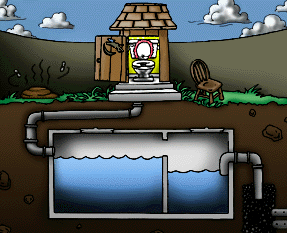


![]()
Animal manure is easily degraded by microbes. In fact, poop is already being degraded before it ever hits the ground, since one third of poop by weight is microbes. In nature, millions of different species of protists, fungi and bacteria recycle poop into carbon dioxide and water. In the past, humans laid their loads upon the roads and walked away contented. In more modern times in developed countries this practice has given way to more organized forms of disposal discussed below.
![]() Pilobolus
Pilobolus
This fungus grows on dung and launches its spores in the direction of light toward an open meadow where grazing animals will eat the spore so that Pilobolus can continue it's life cycle.
Build a dung chamber! To see many fascinating fungi, prepare a dung chamber as follows: Take a hike in a field or forest or park to find some fresh dung from an vegetarian animal. Put this dung on a plate under a glass (ask your parents about which plate and glass). Sprinkle the dung with a little water. Wait a few days, then watch what happens. How many different types of fungal fruiting bodies can you see growing on your dung?
The cartoon above depicts a septic tank. Many homes have septic tanks. When houses are too far away from each other, each house treats its sewage separately in a septic tank. A septic tank is usually an underground tank that contains billions of microbes that slowly degrades sewage. Septic tanks require a longer time to process sewage than do aerobic waste treatment facilities. This is because septic tanks contain microbes that are mainly anaerobic, that is, they grow without oxygen. Organisms grow faster in the presence of oxygen, just the way that you can run faster when you breathe harder and consume more oxygen.
After sewage is digested anaerobically in septic tank, it is treated with oxygen (aerobically) in a leach field. In the leach field, any pathogens not killed by the anaerobic treatment in the septic tank are killed by oxygen in the leach field.
When people live in cities, sewage is collected and treated in municipal sewage reactors. In contrast to septic tanks, community sewage sludge reactors are aerobic, meaning that oxygen is present. Because they contain oxygen, aerobic sewage treatment facilities can treat a lot more sewage in a lot less time. The amount of sewage is determined by the amount of oxygen required by microbes to break down the sewage into carbon dioxide and water. This measurement of the oxygen required by microbes to degrade wastes is known as the Biological Oxygen Demand (BOD).
Poop is recognized by some cultures as a valuable natural resource. It is a potent fertilizer, and is collected as "Night Soil" by people who are euphemistically called "Honey Dippers." Night soil is spread on crops where it serves as a fertilizer.
If sewage is not disposed of properly it can pose serious health problems. More than 500 disease causing microbes are carried in poop. Some of human disease organisms (pathogens) carried in poop include the following:
![]() Salmonella
typhi murium
Salmonella
typhi murium
This bacterium causes food poisoning. Carriers of this disease may excrete 10,000,000,000 (ten billion) S. typhi bacteria per gram of poop.
![]() Giardia lamblia
Giardia lamblia
This protist is the cause of giardiasis, an disease of the intestines which causes gas, cramps, and diarrhea.
(Click here to return to the text you were reading before)
Poop - doo-doo, ca-ca, manure, dung, excrement, feces, fecal matter, human waste, soil, night soil, offal, excreta, castings, crap, s--t, BM, movement, doody, poo-poo, cow pie, horse apples, human pies, log, pile, scat